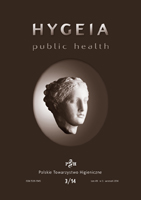Home page |
Editorial Board |
Editor |
Subscription |
Infomation for authors |
Conferences |
Partners

|
|
|
ISSN 1509-1945
 
 
  search by |
Hygeia Public Health 2021, 56(1): 24-30pl
 Unique features of radiation sterilization and hygienization technologiesWojciech Głuszewski Instytut Chemii i Techniki Jądrowej w Warszawie Summary In 1929 Maria Skłodowska-Curie published the so-called radiation inactivation curves, i.e. the relationship between the survival rate of bacteria and the amount of radiation dose absorbed. Through experimentation she proved the statistical nature of the effects of ionizing radiation on matter. The uniqueness of radiation is that sterilization of products can be carried out in a short time, at any temperature (also negative), and the entire volume of the material, unit and collective packaging can be sterilized at the same time. Contrary to traditional chemical (gas) methods, the products do not contain harmful contaminants. Advances in the construction of large ionizing radiation sources have made radiation techniques widely available and economically viable. X-rays, which were used in the tests for the first time, were the last to be implemented in practice. This was due to the low energy efficiency factor of the electron accelerators and, consequently, the high cost of X-rays (German: Bremsstrahlung). The first industrial installation was commissioned in 2011 in Switzerland by the Leoni company. It has been proven that the method of converting the electron beam (7 MeV, 560 kW) into braking radiation is more economically advantageous than cobalt isotope ? radiation installations with activity above 1.5 MCi. Ionizing radiation in industrial installations only causes chemical changes. Artificial radioactivity cannot be induced in this way. Therefore, radiation should not be confused with radioactivity. Research is conducted to identify the irradiation of (radiologically safe) food and dietary supplements. Such measures are only intended to guarantee consumers the right to information about the maintenance method. The use of radiation techniques to preserve agricultural produce requires the permits of the Chief Sanitary Inspector for each food product. Key words: radiation sterilization, hygienization, food preservation, ionizing radiation |


